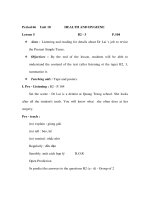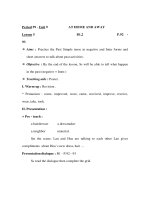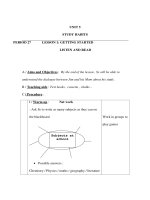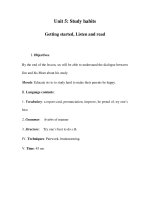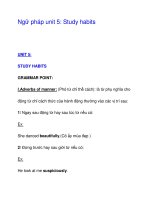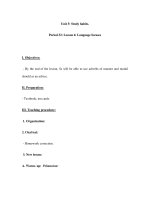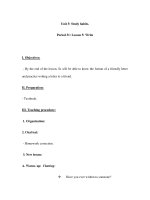5 study sheet enquiries and responses
Bạn đang xem bản rút gọn của tài liệu. Xem và tải ngay bản đầy đủ của tài liệu tại đây (60.37 KB, 2 trang )
1
© Clarity Language Consultants Ltd, 2007
Study sheet
Enquiries and Responses
Enquiries
What is the purpose of this
document?
Letters and emails of enquiry are usually very
simple. The purpose is simply to ask for some
information to be given or sent, and to thank the
person who is going to send it. The letter should
begin by telling or reminding the reader why you
are writing. This may be because you have read
an advertisement, or as the result of a previous
conversation. You need to ask clearly and
specifically for what you want, and if necessary
include information about how the reader can get
back in contact with you.
What should I be careful of?
1. Do not forget to refer to any catalogues,
brochures or advertisements and include any
reference numbers that may be relevant to
your enquiry.
2. Do not forget to include any information
about yourself - address, phone and fax
number, email address and so on - which will
enable the reader to reply.
3. Do be as specific as possible about the
information you want.
4. Do include thanks or an expression using the
word 'grateful'. You are making an enquiry,
not an order.
What sort of language do I need?
Asking a question
We often ask a question in an indirect way, when
giving the reason for writing:
- I am writing to enquire about the price of
your classes.
- Just a note to see if prices are the same as
last year.
Enquire is a more formal word than ask. Note
these different ways to follow the verb enquire:
I am writing to enquire
about the price of tickets.
where I can get tickets.
whether tickets are available.
if tickets are available.
about the availability of tickets.
Asking people to do things
Here are some ways of asking people to do things,
in order of formality, from most to least formal:
1. I would also be grateful if you would send me
a brochure.
2. Could you phone me at 2327 8867 if you can
help?
3. Can you give me a call in the morning?
4. Any chance of a hand with the deliveries?
Thanking in advance
If we ask someone to do something, it is
courteous to thank them in advance.
- With thanks in advance for your help.
- Thank you in advance for your help.
These are both ways to end a letter of enquiry. A
less formal letter might simply end: Many thanks!
Be careful! In some contexts, the expression
Thanks a lot is used sarcastically to indicate that
someone has not been very helpful. It is better to
avoid it.
Responses
What is the purpose of this
document?
Replies to enquiries can be positive, for example
when you give the reader information, or agree to
do something. They can also be negative, saying
you are unable to help, or do not have the
information, service or product that the reader
has asked for.
2
© Clarity Language Consultants Ltd, 2007
Study sheet
Enquiries and Responses
If the letter is positive it may also have the
purpose of persuading the reader to do something
such as buying a product or booking a service. In
order to do this, you might want to include extra
information or attractive-sounding descriptions.
You will certainly want to make a good impression
on the reader by sounding helpful, business-like,
and efficient. Letters replying to an enquiry
usually finish with an offer to give more
information or further help if this is needed.
If the letter is negative, the negative information
should usually be given in a way that does not
preclude further contact: you might be writing to
a potential colleague or customer, or someone
who has been a colleague or customer in the past.
In a negative letter, you might want to offer a
solution to the problem, despite being unable to
help personally.
What should I be careful of?
1. Do not make any promises you cannot
guarantee to keep. If the enquiry has been
about discounts, delivery dates, or other
factors which may be flexible, make it clear
what you generally do. Do not say what you
will do in this case until you have agreed on
something definite.
2. Do not cut off contact with someone you give
a negative reply to. You might need them in
the future. Remember to thank the reader for
the enquiry.
3. Do include all the information the reader has
asked for.
4. Do apologize for not being able to help, if this
is the case.
5. Do invite the reader to call or write to you
again with further enquiries. Include the
information (phone number, email address)
that he or she might need to do this.
What sort of language do I need?
Responding to a question
We usually begin by referring to the enquiry you
are answering. This helps the reader to know
immediately what the email or letter is about, and
can also set a positive tone, especially using
expressions like these:
- Thank you very much for your enquiry of May
9th. (Formal)
- Good to hear from you again! (Very informal -
to someone you know well)
Referring to an enclosed item
Here are some different ways to draw the reader's
attention to something you have enclosed in the
envelope with a letter or attached to an email:
- I enclose a copy of our latest catalogue.
- Please find attached a pdf of our latest
prospectus.
Giving extra information
Sometimes, we can offer more than the original
enquiry asked for. This may persuade the reader
to make additional purchases. These are some
ways to introduce extra information:
- You may also be interested to know that we
can offer vegetarian food.
- You might like to know that we also sell a
range of natural cosmetics.
Inviting more contact
- If you need any further information at all,
please do not hesitate to call me. (Formal)
- Let me know if you need any more info.
(Informal)
Apologizing for not being able to help
- I regret to say that we no longer stock this
software title. However, if you have problems
with your existing copy, our technical support
staff may be able to provide help. (Formal)

